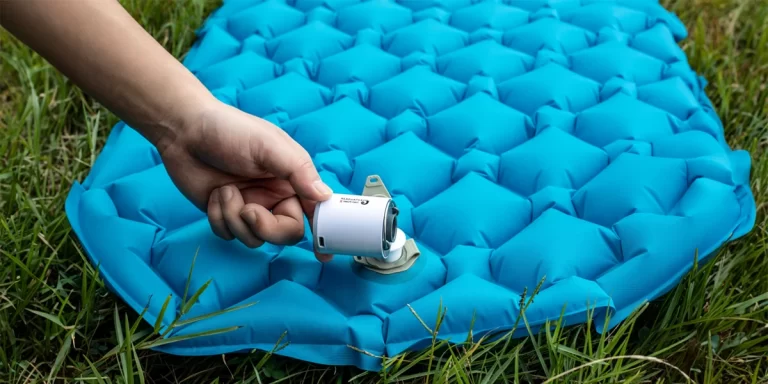

In this post, we’ll dive into the world of backpacking air pumps, exploring their pros and cons to help you decide whether they deserve a spot in your backpack.
I decided to write this post after reading discussions on different ultralight backpacking forums where this little device sparked quite a few heated debates.
So, is this gadget your new best travel buddy, or just extra baggage? Let’s find out.

Backpacking air pumps are compact tools designed for inflating items like sleeping pads and pillows. They are simple, with only a few components.
They can fill your sleeping pad 6-8 times before needing a recharge, thanks to their small battery, about half the size of a smartphone’s.
Unlike traditional methods of blowing air directly into your pillow or sleeping pad, air pumps provide a seemingly more efficient and hygienic alternative.
When you blow air into your gear with your breath, the warm, moist air can lead to condensation inside, potentially causing mold over time. Air pumps help prevent this issue by using the drier air from the environment.
Thus, the primary role of backpacking air pumps is evident: they simplify the inflation process for your sleeping gear along with other benefits:
While backpacking air pumps have advantages, consider their drawbacks before adding one to your gear. Here are key points to remember:
To determine if carrying a backpacking air pump is worthwhile, let’s compare it to a trusty pump sack. Let’s compare the two across key features:
| Feature | Backpacking Air Pump | Pump Sack |
|---|---|---|
| Weight | 1-7 oz | 1-4oz |
| Inflation method | Press button, inflates automatically, can also deflate | Compress and squeeze the bag to build up pressure manually |
| Inflation speed | 3-4 minutes | 2 minutes |
| Durability | Moving parts, lifespan varies by battery | Simple design, durable |
| Noise level | Loud, 75-80dB | Silent |
| Battery dependency | Requires charged battery (extra weight) | None |
| Ease of use | Effortless inflation with a button | Requires some skill to use effectively |
| Temperature performance | Maintains inflation in cold weather | Can be less consistent in cold |
So, what can we conclude from this table?
Because electronic pumps can do more than just inflate, like starting a fire, they’re a good choice for beginners or those camping in the cold. We noticed that some beginners find it hard to use a pump sack and end up blowing air with their lungs.
But for experienced backpackers who like to keep things simple and light, the pump sack is the better option. It works almost as well as an electronic pump but might need a bit more skill. And it never runs out of battery.
But if you’re still thinking about using a backpacking air pump, here are some popular options:
| Brand / Model | Weight oz (g) |
|---|---|
| FLEXTAIL Zero Pump | 1.2 (34) |
| Therm-a-Rest NeoAir Micro Pump | 1.6 (46) |
| FLEXTAIL Tiny Pump 2X | 3.4 (96) |
| Exped Widge Pump | 6.7 (190) |
Whether you choose electronic pumps or manual methods, ensuring well-inflated gear is essential for a comfortable outdoor wilderness experience. Both options have their merits, so consider your preferences and experience level when making a decision.
Remember, the choice between these tools isn’t just about inflating gear; it’s about enhancing your overall backpacking experience and enjoying the adventure. Happy backpacking!
If you’re in search of an ultralight inflatable sleeping pad, check out our TOP 5 guides.
For experienced ultralight backpackers focused on minimalism, a simple pump sack is typically the preferable choice – it’s lighter and requires no batteries. However, for novice campers or those who will face cold conditions, an electronic pump can be worth the modest added weight due to their effortless one-button inflation and ability to maintain consistent fill in colder weather. While pump sacks are a proven method, backpacking air pumps offer key conveniences that enhance the overall experience for some, notably those new to camping or dealing with temperature extremes. Though batteries incur a weight penalty, the ease of use counters this for campers prioritizing comfort over a hyper-focused ultralight approach. Both have a place depending on personal needs and skill level.
When choosing an air pump, look for features like automatic shut-off to prevent over-inflation, portable rechargeable batteries for multi-use, attachments for compatibility with different gear, and additional useful applications beyond inflation like integrated lights. Weighing comfort versus minimalism, electronic pumps can enhance the backcountry experience for some through their versatility and one-button convenience, making sure to select a model with high reviews for reliability in demanding conditions.
Electric backpacking air pumps offer several benefits for campers. They provide efficient and hassle-free inflation, saving time and effort compared to manual methods. These pumps excel in moisture control, preventing condensation inside gear, which can lead to mold over time. In cold weather, they maintain consistent inflation levels, and at high altitudes, they offer a safer and more comfortable option. Many also come with various nozzle attachments and extra features, adding versatility to your gear. Despite some noise, the convenience and efficiency make them a valuable addition to your camping gear.
A pump sack operates through a straightforward manual process: you capture air by either scooping it or letting the wind fill the sack, seal it, attach the nozzle to your camping gear’s valve, and then squeeze or roll the sack to transfer the air into your gear, inflating it. This method is lightweight, compact, and doesn’t rely on batteries or electricity, making it a convenient choice for campers. However, it does require physical effort and may take longer for larger items compared to electric pumps.